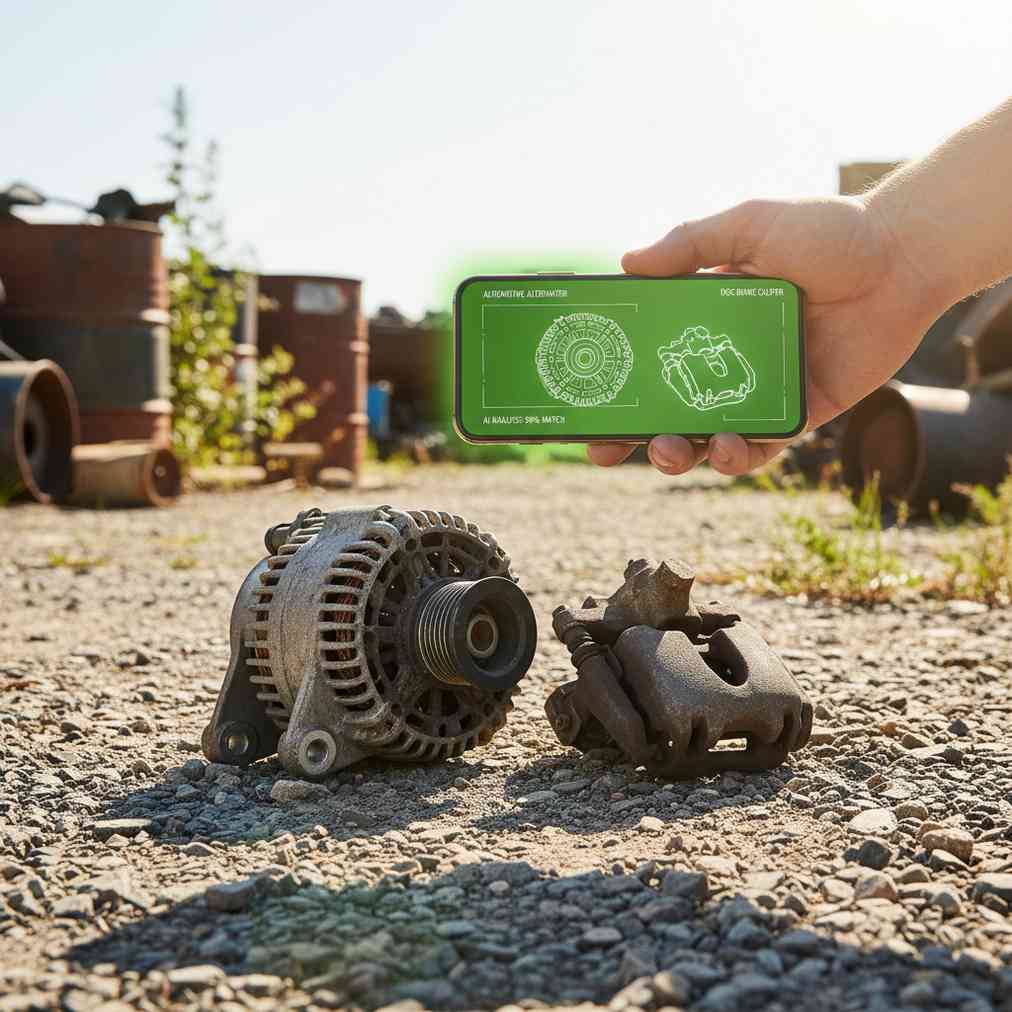The Revolution of AI-Powered Part Identification in Junkyards
The automotive salvage industry is experiencing a technological transformation that’s changing how we identify and catalog used auto parts. Generative AI and computer vision technologies are now enabling junkyard visitors to simply take a photo of a part and receive instant identification, specifications, and compatibility information. This breakthrough technology is replacing the traditional trial-and-error method of part identification that has plagued the industry for decades.
Modern AI-powered part identification tools use sophisticated machine learning algorithms to analyze visual cues like patterns, contours, labels, and design elements in photographs, comparing them against vast databases of known automotive parts. This technology is particularly valuable when searching through salvage yards near you, where manual identification can be time-consuming and often inaccurate.
Understanding Core AI Technologies for Part Recognition
Computer vision algorithms form the backbone of these identification systems, working in conjunction with optical character recognition (OCR) to read part numbers, manufacturer logos, and other identifying markings. The technology goes beyond simple classification, offering detailed specifications, compatibility information, and even condition assessments based on visual inspection of wear patterns and damage.
| Technology Component | Function | Accuracy Benefit |
|---|---|---|
| Computer Vision | Analyzes shapes, contours, and visual patterns | 85-95% identification accuracy |
| OCR Technology | Reads part numbers and manufacturer labels | Reduces manual lookup time by 90% |
| Machine Learning | Improves recognition through pattern learning | Continuous accuracy improvements |
| Database Matching | Compares against known part catalogs | Provides compatibility information |
According to industry research, generative AI can improve inspection accuracy by up to 9 times by significantly reducing false detection rates. This improvement is crucial when dealing with used parts where condition assessment is paramount for determining usability and value.
Essential Photography Techniques for Optimal AI Recognition
The quality and composition of your photographs directly impact the AI’s ability to accurately identify parts. Following proven best practices for automotive part photography ensures maximum recognition accuracy and detailed results.
- Single Part Focus: Frame only one part per photo to avoid confusion and improve accuracy
- High Resolution Images: Use cameras capable of capturing fine details, textures, and small markings
- Optimal Lighting Conditions: Ensure even lighting to minimize shadows and highlight critical features
- Clear Part Numbers: Make manufacturer labels, part numbers, and logos clearly visible
- Multiple Angle Coverage: Capture various perspectives including mounting points and connection interfaces
- Clean Surface Preparation: Remove excessive dirt or debris that might obscure identifying features
Professional salvage operators and AI-powered image search specialists recommend taking photos from at least three different angles: front-facing, side profile, and a close-up of any visible markings or connection points.
Crafting Effective AI Prompts for Part Identification
While the photograph serves as the primary input, providing contextual text prompts significantly improves AI confidence and accuracy. Strategic prompting helps the AI focus on relevant details and provide more comprehensive results.
“Providing specific context like vehicle make, model, and year can improve identification accuracy by up to 40% compared to image-only submissions.”
AI Parts Recognition Research Study
Basic Identification Prompts
- General Query: “Identify this automotive part and provide specifications”
- Location Context: “This part was removed from the engine bay, please identify”
- Function-Based: “Identify this electrical part and its function in the vehicle”
Advanced Contextual Prompts
- Vehicle-Specific: “Identify this transmission part from a 2015 Honda Accord”
- Condition Assessment: “Analyze this brake rotor for wear patterns and usability”
- Compatibility Query: “What vehicles are compatible with this alternator?”
- OEM Number Request: “What is the OEM part number visible on this component?”
Current AI Tools and Platforms for Junkyard Operations
Several specialized platforms now offer automotive part identification services designed specifically for salvage yard operations and individual part hunters. These tools integrate advanced machine learning with comprehensive automotive databases.
| Platform Features | Accuracy Rate | Best Use Case |
|---|---|---|
| Real-time identification | 90-95% | On-site junkyard visits |
| Compatibility matching | 85-92% | Cross-reference applications |
| Condition assessment | 80-88% | Quality evaluation |
| Price estimation | 75-85% | Market value determination |
Modern AI systems can process images and provide results in seconds, dramatically reducing the time spent manually searching through catalogs or making educated guesses about part compatibility. This technology is particularly valuable when dealing with OEM parts where precise identification is crucial for proper fitment.
Industry Applications and Integration Trends
The integration of AI technology into junkyard operations extends beyond simple part identification. Modern salvage operations are implementing comprehensive AI systems that handle inventory management, condition assessment, and customer service automation.
- Automated Inventory Systems: AI cataloging reduces manual data entry by up to 85%
- Quality Control Integration: Automated defect detection for incoming parts
- Customer Service Enhancement: Instant part lookup and compatibility verification
- Pricing Optimization: Market-based pricing using real-time data analysis
- Cross-Platform Integration: Seamless connection with e-commerce and inventory systems
Professional operations are finding that AI integration not only improves accuracy but also significantly reduces labor costs associated with manual part identification and cataloging. When combined with auto recycling best practices, these systems create more efficient and profitable operations.
Maximizing Success with AI Part Identification
To achieve optimal results when using AI for part identification in junkyard settings, consider implementing a systematic approach that combines proper photography techniques with strategic AI prompting and verification methods.
Step-by-Step Identification Process
- Preparation: Clean the part surface and ensure adequate lighting
- Documentation: Photograph from multiple angles with focus on identifying marks
- AI Submission: Upload images with detailed contextual prompts
- Verification: Cross-reference results with physical part numbers when visible
- Compatibility Check: Verify fitment information against vehicle specifications
This systematic approach is particularly valuable when sourcing high-value used auto parts where accuracy is crucial for successful installation and customer satisfaction.
Future Developments in AI-Powered Auto Salvage
The future of AI in automotive salvage operations promises even more sophisticated capabilities, including predictive compatibility analysis and automated condition assessment that can determine not just what a part is, but how long it’s likely to function in service.
Emerging technologies include 3D scanning integration, augmented reality overlays for installation guidance, and machine learning models that can predict part failure patterns based on visual wear analysis. These advances will continue to transform how we interact with and utilize salvaged automotive parts.
For those looking to sell vehicles for parts, AI technology is also revolutionizing the process by providing instant vehicle assessments and part valuation. If you’re considering this option, you can get an instant quote for your junk car to understand its salvage value before dismantling.
Implementation Recommendations for Success
Successfully implementing AI part identification technology requires understanding both its capabilities and limitations. While these systems excel at identifying common parts with clear visual characteristics, they may struggle with heavily corroded parts or those from very rare vehicle models.
The key to success lies in combining AI technology with traditional identification methods, using the technology as a powerful first step while maintaining the ability to perform manual verification when needed. This hybrid approach ensures the highest accuracy rates while maximizing the efficiency gains that AI technology provides.
As this technology continues to evolve, staying informed about new developments and regularly updating AI tools and databases will be essential for maintaining competitive advantages in the rapidly changing automotive salvage industry.





Leave a Reply
You must be logged in to post a comment.